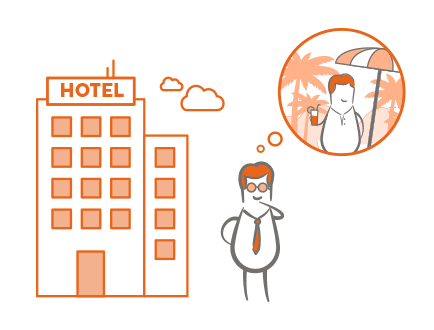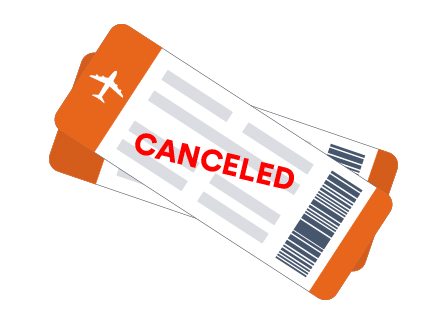Travel blogs reveal the secrets and special points of interest for our dream destinations, describing personal experiences and making observations that cannot be found in any holiday catalogue. Re-living the experience is what makes a travel journal so appealing for readers. It allows their eyes and ears to travel to distant countries and unknown places before they actually decide to go there.
Travel is also a widespread topic in the world of literature. As early as the 19th century, people started to escape from their everyday lives by reading books. For the first time, sensational experiences such as the story of Robinson Crusoe or the hunt for the white whale, Moby Dick, mixed reality with fantasy. Utopian and fantasy stories such as Jules Verne’s Journey to the Center of the Earth or Jonathan Swift’s famous satirical travel diary, Gulliver’s Travels, take the reader to distant and wondrous places. These places are not necessarily desirable or even safe to travel to, but a reader can safely experience the thrill of the journey through the book. The heroic journey, which originated from the ancient Greek Mythology, is still the basis of almost every good story.
The desire to travel is the reason why so many people read travel diaries even if they are not currently planning a holiday. And since our planet has plenty of far and wide destinations to offer, the travel journal market is booming like never before, so much so that travel costs or affordability factors are taking second place for the time being. Many people enthusiastically read about climbing tours in the Himalayas or kayaking in the Grand Canyon – without any serious desire to try out these thrilling adventures for themselves.
In this article, we are mainly focusing on commercial travel reports to encourage readers to book their next holiday in the subject destination as well as individual experiences that are directly related to corporate travel. The latter falls within the scope of influencer marketing and independent research for travel-loving Internet users. Even the largest tourism companies have now realised that their customers inform themselves in advance. Ads are increasingly being ignored – there is more demand for personal experience reports, travel diaries, photos and videos of other travellers. This has put local travel providers under greater pressure to deliver on the promises of their glossy brochures.
Your passion for travelling is the most important requirement in any case.
What you will learn on this page:
What makes a good travelogue?
A good travel blog should encourage the reader to recreate the trip in their mind through your descriptions. It is about arousing the interest to travel to distant and exotic destinations. Your stories should encourage people to do the same and embark on a trip themselves. Some people simply don’t dare to experience the freedom of going on a backpacking trip through the mountains of Nepal, for example. But because you’ve explained how to do it, they are more likely to give themselves a push and follow your footsteps.
This is why a good travelogue must go beyond pure experience reports and be highly helpful to your readers. The more complicated the trip, the better you should, for example, be familiar with the necessary equipment, the environment and the laws of the respective country. Use your personal expertise or bring an expert into the team, whose experience stories can be turned into reports.
The layout also plays a big role, because the best texts are of no use if you cannot present them attractively. Create a webpage layout with meaningful headings, subheadings and paragraphs that loosen up the flow of text and break it down into easy to digest content. Images are extremely important because they attract attention and immediately provide an idea of what the content is about. Immersive videos can also be embedded in the articles. Some travel bloggers will even set the scene mainly as a video portal.
Always use responsive design to ensure that your travel reports are displayed optimally on mobile devices. This option is now standard for most themes and templates for CMS and website building tools.
Don’t delete any of your previously published content, since even old posts – especially if they ranked high – are still referred to frequently. Many people simply like to read stories and enjoy your writing style, while others may want to learn what has changed compared to the previous years. The more extensive your travel guide content becomes, the more it affects your status as an influencer. It will come across more trustworthy when it becomes clear that you have been travelling the world for years. Travel blogs with long-lasting appeal are good – but you have to earn this status with a lot of patience and exciting travel stories.
If you are writing about trips or activities that require special tools, make sure you use quality equipment. Many readers will be just as interested in the equipment and its correct usage as the actual travel report.
You are the deciding factor
Give your travel blog or portal a distinctive name that expresses the style of your travel stories. Introduce yourself to your audience and be as authentic as you were in all your texts and videos.
Would you like to provide valuable travel tips that inspire your readers?
Our authors are the right contacts when it comes to creating exciting content.
How to write an inspiring travel journal
The greatest art when writing travel reports is to remember feelings, impressions and moods and to incorporate them into your texts. The longer the trip to be described, the harder it is to authentically reproduce such emotional factors. Even small tips and tricks that you collect during your stay in a distant place will quickly be put at the back of the mind. In order to keep your memory fresh, you should take notes while you are travelling. This will make it easier for you to write your exciting travel reports later at your desk. Alternatively, you can blog on the go and share your experiences directly with the online community thanks to WLAN and Wi-Fi.
When writing a travel blog, it is best to always show a positive attitude. After all, you want your readers to follow your steps and book the same trip. Many people are stressed by their daily routines or their job and long to take a relaxing holiday. Show them how much fun you had on your travels and let your feelings flow into words.
Decide on a suitable tense and keep it the same as throughout the content. This is why the present tense can help to capture a special moment:
As the splattering waves hit our kayaks, we race rapidly with the glittering fish that come whizzing past us on the left and right of the boat.
The past tense always works best. It is particularly suitable for all quieter activities and also for longer trips. Impressive moments often gain more weight:
I’d never seen a more impressive starry sky than that night in the desert. Nobody wanted to go to sleep – we sat around the campfire until dawn with sweet fruits and tea.

SEO-content writing
Always keep in mind that your texts must also be found by search engines. SEO is also important for writing a travel journal or guide. However, it should not be difficult to find the concise keywords (country names, place names, local activities and special features, etc.) and skillfully incorporate them into your travel blog.
Possible topics for your travel blog:
The choice of topics is limited only by your imagination and your travel experiences. Always keep your eyes and ears open while travelling so that you can write every interesting detail, observation and all your insights in your travel diary.
Here is an overview of topics that many readers love reading about online:
Accommodation:
Describe the quality and facilities of B&Bs, apartments or hotel rooms. Also highlight the fine details of the architecture or the beautiful view from the balcony. Was the staff friendly and competent? Were the sanitation facilities in order? Holidaymakers on backpacking, cycling or hiking trips want to know where there are overnight accommodations or places to camp. Perhaps on your last trip, you discovered a charming log cabin where you could warm up by the fireplace. For extreme travellers, an overhanging rock under which a crackling fire can be lit is a welcome place to sleep.
Restaurants, bars, cafes and tea houses:
There are cultural and culinary hubs in every country. Whether cosy cafes in the old town of Paris, hip sushi bars in the streets of Tokyo or a small bar filled with cigar smell in Havana – if you write your experiences in lively and elaborate words, your readers will sit with you at the bar, lounge in the rattan chair or hang out next to you in the hammock. How did you find these places, what have you experienced there? The atmosphere often counts more than what’s on offer. You can also write about food and drinks in order to attract foodies.
Culinary specialities from all over the world:
Food is one of the main reasons for many people to decide to travel to far and wide destinations. When you describe the best dishes on your travels, you should provide readers with mouth-watering details. A travel blog focused on food should also mention unusual delicacies for European readers. How about a bite of pufferfish in Japan or a piece of fermented shark in Iceland? In your food journal, feel free to describe how these dishes can be prepared at home. If your culinary story is tempting enough, the readers may soon hop on the plane to try the delicacies for themselves.
Adventures and experiences:
You will experience an incredible number of adventures on your travels. It is often the small activities that will linger in your mind. So, in addition to describing the hugely loud and popular events, dedicate a few lines for the quiet moments. Perhaps you were particularly fascinated by an old inscription on a house wall or a cool mountain stream that refreshed you on a hot summer day. Write down how you felt during those moments. Even bad or negative experiences should be included in your travel diary. The way in which you have overcome problems or obstacles on your journey can be a guide for your readers on their travels. It is often the mishaps you experienced during your travels that are laughed at the most later.
People and their customs:
It is the inhabitants of a country that give the place a true identity. Personal encounters, mixing with a foreign culture and trying out other lifestyles are part of every holiday experience. Talking to people who are from a different culture will reveal a completely new perspective on our world. Tell your readers about these experiences. Encounters with other travellers can also create interesting stories.
Landscape and nature:
If your own country’s local pastures and forests are no longer inspiring you, a change of scenery is necessary. The wonderful landscapes and natural beauties of distant countries on postcards attract the travellers, but so should a travel blog. Tell your readers about the white sandy beaches of the Caribbean, the lush greenery of the Scottish Highlands or the rugged majesty of the Grand Canyon. Even if the beauty of a country is not the real reason for the trip, it will still complete your visit. Especially in times of increasing environmental awareness and the desire to get involved in environmental protection, nature trips are becoming ever-more popular. Today, safaris are more common with a camera than a rifle, while whales are better watched than hunted.
Popular and lesser-known sights:
These are the cornerstones of all the classic holiday activities that go beyond sunbathing on the beach or by the pool. Many trips are designed from the outset to visit as many monuments, museums and historical buildings as possible. As a travel blogger, you tell your readers which of these places are really worth visiting. In addition, you should always look for lesser-known sights alongside the well-advertised attractions. List all the details that are important for travellers: where can you find tickets, when are the peak visiting times, what parking options are available and can the sights be reached on foot, by boat or by donkey and cart, etc.?
Here is some general information about travel arrangements and holiday destinations as part of your travel journal ideas:
What to pack:
Your readers will need to know what they should be taking with them to the country they are visiting. Some types of travel require special equipment – can it be transported to the holiday spot or rented there? It is generally advisable to create a what-to-pack list. Depending on the scope of the trip, you can even dedicate your own blog entry to the packing process. Also describe what kind of vehicle you are travelling with or list the necessary equipment for mountaineering, diving or paragliding. Keep in mind that in the role of an influencer, you have an impact on the purchasing decisions of your readers – only write about the equipment or travel accessories if you have actually tested their quality yourself.
When is the best time to travel?
In the monsoon season, a holiday in the tropics won’t be a pleasant experience. When is it especially hot or cold in the subject country? Dates of popular festivals and events are also part of many holidaymakers’ travel itinerary.
What health precautions should be taken?
Different vaccinations are often required before visiting tropical countries or destinations with poor health care facilities. Holiday resorts and hotels should also mention whether they are wheelchair friendly and suitable for people with mobility problems.
What is the security situation of the country?
Not all countries are as politically stable as the ones in Central and Western Europe. Adventure trips such as jeep safaris, hiking or climbing tours often take you through less developed regions that are beyond the control of the respective country. Inform your readers openly and honestly if such risks exist.
What are the laws for tourists?
There are no separate laws for tourists – they are subject to the same laws as the locals of the respective country and must comply with their regulations. For example, some countries have very strict dress codes in public, do not allow alcohol or strictly observe driving speed limits.
What are the traveller’s obligations?
Does the accommodation need to be cleaned and tidied up before checking out? In some cases – for example on high-risk adventure trips – special health and safety training may be necessary in advance.
Are there rental cars or other means of transportation offered?
If you don’t want to just lie by the pool whilst on holiday, you may have to hire a car, bicycle, or a boat. Make sure you write about your transportation experiences in your travel blog. While it should be easy to get a rental car in mass tourism locations, it may be necessary to book it in advance in the less developed countries.
What to do in case of travel cancellations?
For example, will a percentage of the travel expenses be payable even in the event of cancellation? What can your readers do if they have to end their holiday prematurely due to the fault of the travel provider? For such legal questions, we generally recommend that you seek the advice of a lawyer so that you do not give false or outdated advice to your readers.
Where can I exchange currency or get cash out?
Since nobody wants to be left without cash when travelling, this is an extremely important point, especially for adventure travellers in distant countries.
Any recent changes to be made aware of?
Nothing stays the same in a country and even untouched holiday destinations can change over time. It can be either a man-made or natural occurrence, such as a new construction site, changes to the country’s law, floods, earthquakes, or even war. It is, therefore, recommended to write regular updates about your favourite places so that your readers know whether they can still find those sights or places to stay that you had previously described. For example, is that cosy little beach bar you had mentioned before still there? Are the old hiking routes still accessible or have weeds overtaken the trails? Are daring tourists still allowed to participate in the Running of the Bulls event in Pamplona?

Share your memories by providing your readers with insider tips:
Create a travel blog today with the help of our authors.
Things to avoid in a good travelogue
Long before YouTube, Instagram, travel blogs or TV holiday shows came about, there were slide shows. These consisted of mini-photos – the slides – being shown on a screen via a projector. Some people may recall such experience at a family gathering in a darkened room. If you belong to that generation, then you might agree that such slide shows were like watching paint dry… ultimately very boring. A countless number of photos pass by an increasingly sleepy audience under the monotonous rattling of a projector, followed by the uninspiring comments from the speaker saying things like: “Anna and I are standing by the pool here”. The few good photos that do appear pass too quickly and so do the interesting stories.
We are in no way knocking this old technology since slide shows could be quite funny. In fact, slide shows can be quite useful as long as the presenter makes a selection of the best pictures in advance and has really great stories to tell. So be sure to provide your readers with plenty of great photos or stories. A high-quality image in which composition, colours and image sections blend well together or capturing a very special moment is worth more than a whole series of pictures with interchangeable themes. What’s more, there should be no room for boredom.
A travelogue should obviously be free of misinformation. Nothing is more disappointing than arriving at the holiday resort and facing a completely different scene. Even if you describe your own facilities, or write on behalf of a travel agent, you should be careful not to go overboard. Of course, circumstances can change over time, but a recent travelogue must give readers the opportunity to adjust to any possible changes. For example, is construction site noise to be expected in a certain period of time? Can beaches be closed due to jellyfish, blue algae or similar seasonal phenomena?
Different types of travel guides and blogs
An online travel journal can be created using different media and content. For example, rankings and lists in which travel destinations or holiday locations are compared tend to be very popular with readers. It is generally advisable to accompany your travel report with photos. This is because pictures complement your texts in a vivid way and record the most important stages and experiences of your trip. Actually, no travel report is complete without pictures since they provide readers with a closer look at the destination, thus prompting them to book a trip themselves. An important tip: by using your own pictures you prove that you have actually been there and experienced all the described points of interest in person.
Here are some suggestions on how to create a travel guide using the best online strategies:
Content Management Systems for travel reports
In addition to accounts on social media platforms such as Facebook, Twitter, Instagram or YouTube, you should also create an Internet presence that belongs only to you. In addition to various modular website systems, content management systems (CMS) are particularly suitable for this task. Among these software solutions, the open-source system, WordPress, stands out because it was specially developed for blogging purposes. WordPress is very easy to use so you can create your travel blog without external help.
Since it is one of the most widely used CMS worldwide, you will find thousands of different design templates and plug-ins for WordPress that can be used to expand and personalise your page. You can even create an online shop if you want to sell travel accessories, equipment or other travel-related products. Of course, there are other CMS options that you can use for your online travel guide.
An important tip: remember to secure your domain with the name of your blog from early on. It would be very annoying to plan your entire website and then find out that your desired domain name has already been taken.
Examples of successful UK-based travel bloggers
It’s always good to find role models and inspiration from successful travel bloggers. Here are a few examples:
Vicky Flip Flop Travels
The high ranking travel blog from the UK travel writer, Victoria Philpott, shows how to travel the world on any budget. For anyone who wants to travel on a shoestring or is looking for a luxury destination, Vicky has covered the world’s most interesting and inspiring places as well as must-see festivals. The aim of this travel blogger is to give her readers the knowledge and courage to embark on the journey on their own.

Helen in Wonderlust
Helen Davies is an avid travel writer based in the UK with a special love for Africa. Her epic trips to this diverse continent have led her to gain a huge following on social media sites.

The Petite Cook
Andrea is a London-based self-taught chef with a large following (over 150,000) on YouTube and other social media sites. Her blog shows her love of authentic foods
Ship Monk
This is an award-winning cruise blog by Dave Monk, which started in 2005 and covers over 27 cruise lines. Dave has also written for Daily Mirror, Daily Telegraph, and Daily Star, to name some of the few newspapers. His latest blog is the top ten must-visit cruise destinations for 2020.

The best travel blog always comes from the heart
If you enjoy travelling, let your passion flow into your blog posts. Unless you are already blogging live from the subject country, a travel diary will help you to remember the most important experiences.
Experienced authors can transform storytelling into exciting blog posts. If you lack the time or experience to write texts that awaken the senses in your readers, you can use external copywriters. As a travel blogger, you live the dream of many people. We wish you a lot of fun and great experiences on your next travels – and of course, good luck writing your travel reports!
All types of travel guides makepopular online content
Do you need high-quality text? You’ll find the most suitable authors with us.

















No comments available